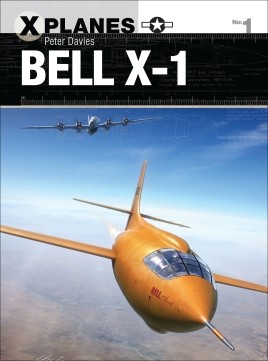X Planes - Bell X-1

Osprey Publishing
S u m m a r y |
| Publisher and Title: |
X Planes - Bell X-1
Author: Peter E. Davies
Illustrators: Jim Laurier & Gareth Hector
|
| ISBN: |
978 1 4728 1464 7 |
| Media: |
80 page softcover paperback. Also available as an ebook in either ePub or PDF format from the publisher |
| Price: |
£12.99 available from directly from Osprey Publishing
or £10.99 as an eBook from the same location. |
| Review Type: |
First Read |
| Advantages: |
An easy read covering the history of the Bell X-1 research program with excellent period photos and diagrams. It’s a quick read too. |
| Disadvantages: |
Though not necessarily a modelling reference there are some great photos. Nothing else noted. |
| Conclusion: |
This publication is well worth the sale price. Although a brief summary it is an excellent book on the subject. The further reading list is handy if you wish to further research the subject. |
Reviewed by Mick Drover

HyperScale is proudly supported by Squadron.com
This is the first book released by Osprey Publishing in the X-Planes series.
The Bell developed X-1 aircraft and the name Chuck Yeager are synonymous names associated with the early years of supersonic aircraft research. two names that modellers will know of with varying degrees of knowledge. I sat in the category of knowing the names of both subjects and a bit of knowledge about them albeit through the movie "The Right Stuff" released back in 1983.
The book begins with the early involvement of the Brits initially covers the involvement of the British research information that was provided to the US. I'd always thought that there had been some jealousy by the Brits considering the amount of information provided and the lack of return assistance however I soon realised that they were more than willing to provide the information, perhaps vainly expecting something in return.
I found particularly interesting the section that covered the selection of Bell as the chosen contractor including the crewing problems that they encountered. The newly developed US Air Force wanted to gain kudos over other services so were keen to accelerate the program however sensible measure was received from the ever conscious National Advisory Committee for Aeronautics (NACA). Until reading about this I never realised that the USAF was so beset on breaking the sound barrier ahead of the other services. The US Navy was operating the D-558 program during the time with similar goals so their eagerness was understandable.
The Chapters of the book are as follows.
Chapter One - Introduction
This chapter is a brief introduction in the lead up period prior to the X-1 program and it’s embryonic stages and an introduction to the pilots, including Chuck Yeager, that flew them.
Chapter Two - Origins
This chapter covers the period where supersonic speeds seemed to be a myth. Discussed here are the issues that proponents of the war encountered when approaching supersonic flight. The research conducted and the characters involved during this period is covered.
Chapter Three - The Saffron Bullet
Discusses the development if the X-1 and the details associated with it.
Chapter Four - Riding the Rocket
Covers the are of flying the X-1 and the problems and solutions that were encountered and how they were solved.
Chapter Five - “Poking Through Jello”
Discusses the flights leading up to the breaking of the sound barrier including the famous X-1 “Glamorous Glennis” piloted by Chuck Yeager who broke the sound barrier on October 14, 1947.
Chapter Six - X-1 - The Second Generation
Discusses the further flight research conducted by the later generation of jets developed up until the Bell X-1E.
Chapter Seven - X-1 Legacy
A brief discussion chapter that looks back at the X-1 research program and the achievements that were made by it.
I managed to read this book in three evenings and after doing so I had a much better understanding of but also more interest in the Bell X-1 program and the associated aircraft that flew.
Peter Davies and his illustrating cohorts Jim Laurier and Gareth Hector have done a great job in covering the development and lifespan of the X-1 and although it might not be a ‘modellers’ reference book this publication provides excellent coverage of a program that was writing the rules as it progresses. It certainly has ‘the right stuff”.
A big plus is the additional reading material list that is provided at the back of the book.
Thanks to Osprey Publishing for the sample.
Review Copyright © 2016 by Mick Drover
This Page Created on 1 December, 2016
Last updated
1 December, 2016
Back to HyperScale Main Page
Back to Reviews Page
|
